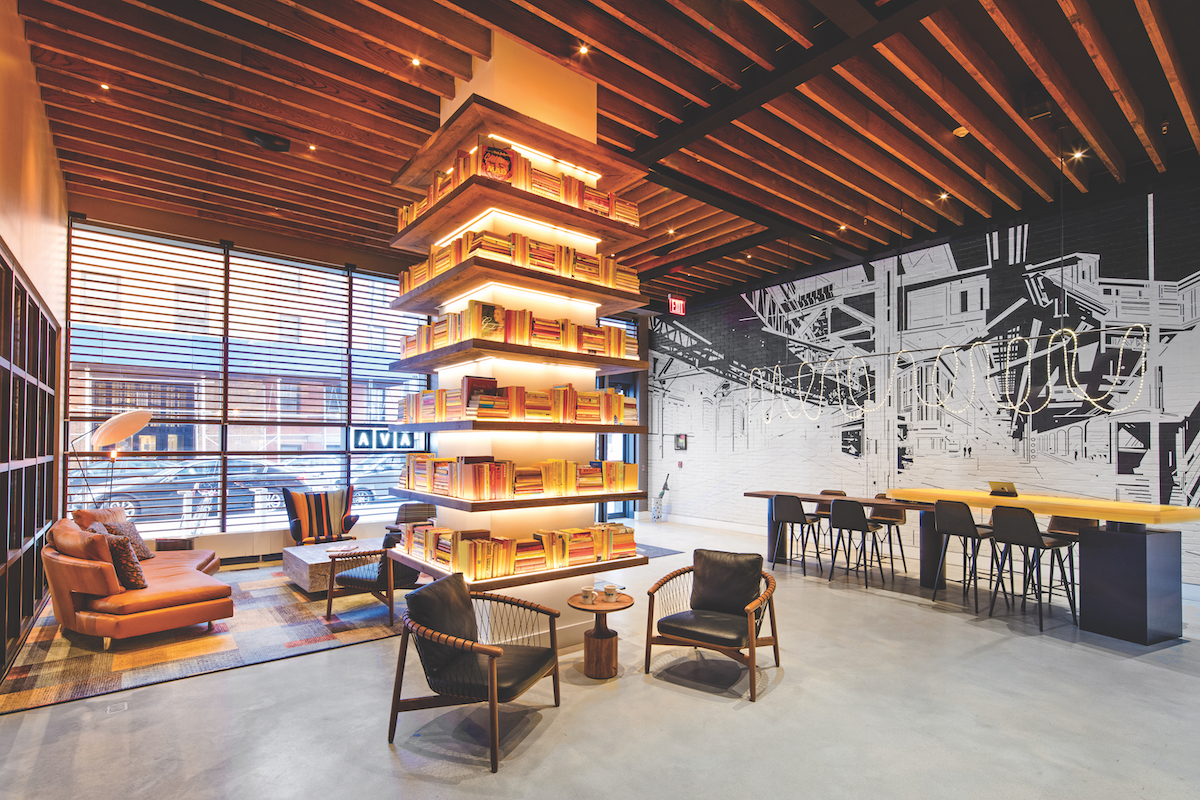AvalonBay Communities, the fourth-largest owner of apartments in the U.S., holds more than 85,000 apartments, in 291 communities. The publicly traded equity REIT traces its origins to 1978 and the formation of Bay Apartment Communities, which merged with Avalon Properties Inc. in 1998.
The developer/owner-operator is active in 11 states—California, Colorado, Connecticut, Florida, Maryland, Massachusetts, New York, Rhode Island, Texas, Virginia, and Washington—and the District of Columbia.
Critical to AvalonBay’s success is its single-minded focus on upgrading the residential experience, especially its attention to small design details that could easily be overlooked. To be responsive to evolving consumer tastes, AvalonBay surveys residents at move-in, mid-lease, and move-out to ask whether they would recommend AvalonBay, and why—or why not.
“We continue to grind away on unit layouts, not just on the eye candy,” said Jong Chung, AIA, Vice President of Design. “We’re engineering the space so it is seamless and painless for residents.”
That intense focus includes tweaking standards for the height of countertops, the placement of electrical outlets, and the positioning of doors—features that may not catch a prospective renter’s eye on a walkthrough, Chung acknowledges, but which make the space more livable and improve the odds of gaining and retaining residents.


DOING THINGS IN THREES
The company’s culture is rooted in three core values: “integrity,” “a spirit of caring,” and “a focus on continuous improvement.” Michael Feigin, EVP/Chief Construction Officer, who joined AvalonBay in 2014, said he found it “refreshing” to witness how fervently AvalonBay employees embraced these values. “I’ve worked in places where nobody knows the company’s core values,” he said.
The company offers three brands to meet the needs of its three target markets: Avalon, its high-end luxury option; AVA, which appeals to “youthful lifestyles”; and eaves by Avalon, its “value-oriented” choice.
AvalonBay’s business strategy is also three-pronged:
1. A decentralized development and centrally led, self-performing construction platform, where the 11 regional offices lead the charge locally. Strategic direction and administrative support services for development is provided by leadership on each coast; the construction wing gets its direction and support from national headquarters in Arlington.
2. Ongoing investment in its portfolio through redevelopment, remerchandising, and capital expenditure where there is an immediate maintenance need, or where there is a market-driven opportunity to reposition a community. (AvalonBay redevelops roughly 5% of its portfolio every year.)
3. Acquisition of existing assets to more deeply penetrate strategically targeted markets, as evidenced by its recent expansion into Southeast Florida and Denver.

AVALON – “Where discerning renters live comfortably”
- Newer, quiet community near shops, restaurants, entertainment
- Higher rent, “best for the money”
- Mostly 2BRs, then 1BRs; fewer studios
- Larger living spaces (10-15% larger units)
- Feature options
• Current Avalon standard
• Fine Living (upgraded kitchen, bath)
- Amenities: “aspirational bordering on luxury”
- Spa-like fitness center
- Dog park, pet wash station
- Discounts at lifestyle retailers
- Concierge/assistance services (select communities)
Photos: photos: left, Alan Schindler; center, Bill Horsman; right, Daniel Gaines
The company’s hold-and-operate strategy means that the design and construction teams must “futureproof” properties against changes in rental trends, said Chung. Amenities and unit designs have to be nimble, so that they can be easily remodeled as consumer tastes evolve. “We don’t want to just jump on the latest fad,” said Chung, citing iPod stations that were all the rage just a few years ago.
For example, AvalonBay has shifted its kitchens from the galley or U-shaped designs that were once common to a more open look; islands have been added to provide convenient working space. Recently, the company has been outfitting kitchens with islands that are not only in sync with accessibility standards but also can be easily removed should kitchen islands go the way of the wall-mounted can crusher.
MORE CONSISTENCY IN THE CONSTRUCTION PROCESS
Feigin spearheaded the formation of a national construction management team to support the company’s six regional construction groups. “This has allowed us to bring a level of consistency to the construction process that we didn’t have before,” he said. The company has standardized its technology on Oracle’s Primavera Unifier (which it has rebranded internally as “IBeam”) for project management and Asta for scheduling and estimating, and has gone nearly paperless on the jobsite. The new structure has also led to more national purchasing agreements that reap better deals with vendors.
This coordinated approach to design and construction has enabled greater sharing of ideas and strategies between regions, said Feigin. Last year, after the White House announced stiff tariffs on goods from China, AvalonBay’s procurement team reached out to its design and local construction teams for possible new sources of quartz countertops, which AvalonBay had been buying from China. In the end, said Feigin, the firm struck a deal with an American manufacturer for higher-quality quartz countertops at almost the same price as the Chinese product.
The headquarters-based national support team of designers and construction professionals produces a steady flow of new ideas and approaches. The design group covers architecture, interior design, and design resources, which conducts R&D on new products. Other headquarters designers develop unit prototypes and design standards that guide consultant architects as they flesh out early-stage skeletal designs for specific properties. Certain elements—the minimum size of a fitness center, for instance—must be applied universally. “This shortens the design process because the consultants don’t start with a blank piece of paper,” said Chung.

AVA – “For aspiring, urban-minded, youthful lifestyle” individuals
- Active day/night neighborhood close to public transit
- Highest rent (often split)
- Higher 2BR mix (often with roommates)
- Smaller, “engineered” living spaces
• Sliding or barn doors
• Wood-like vinyl flooring
• Gear wall (select units)
• Charging station
• Shower-only in 1BRs and studios
- “Energized, stylish, contemporary” community spaces
- “Energized” fitness center
- Indoor/outdoor chill space
- DIY apartment personalization program
- Technology-leveraged services
Photos: left to right, Sam Kittner, Mike Rixon, Brian Parks
While performance standards must be met, regional variations in wall and ceiling assemblies are occasionally permitted, said Chung. For example, Seattle’s ultra-tough seismic code requires walls to be able to withstand lateral shaking during a tremor. As a result, in Seattle, AvalonBay’s fairly prescriptive guidelines for sound attenuation in wall assemblies have been modified to conform to local seismic requirements.
Feigin acknowledged that lack of acoustic privacy has been a source of criticism for years in resident surveys. He said the company’s standards committee, composed of members representing operations, construction, design, asset management and development from several regions, has implemented standards that have steadily improved acoustics in its buildings. (About 80% of its projects under construction are wood-frame; the rest are steel or concrete superstructure.) Every new project undergoes testing by an acoustic consultant. “You can’t make the buildings perfectly soundproof, but complaints have diminished over time,” said Feigin.
ALSO SEE: Multifamily visionary: The life and work of architect David Baker
AvalonBay regional construction crews inspect workmanship on site to ensure that construction methods are up to the firm’s quality standards. The company hires building envelope consultants for every project, with particular attention to preventing damage from water intrusion. “That can be an expensive proposition,” said Feigin, so preventing it is well worth the consultants’ fees.
The company has also made significant improvements to fire safety protocols on its construction sites. In 2017, an early-morning fire destroyed nearly half the units of an unoccupied 235-apartment AvalonBay project under construction in Maplewood, N.J. The cause of the fire was later ruled “undetermined” by local authorities.

Eaves by Avalon – “For cost-conscious renters hoping for something more”
- Older, quiet, low-key community
- Lowest rent possible, “value seeking”
- Mix of 1BRs and 2BRs
- Moderate-size living spaces
- Feature options
• Basic kitchen/bath/finishes
• Upgraded cabinet faces, flooring, fixtures
- Basic extant amenities
- Clean, basic fitness center
- Dog run
- Pool, clubroom, BBQ optional
- Upgraded laundry room (where in-unit laundry not available)
- Available at some locations:
• Security deposit refund upon renewal
• Two-year lease/rate lock
• “eavesextras” discounts/rewards
Photo: Alan Schindler
Company officials vowed to rebuild the complex and implemented stringent new rules to prevent jobsite fires. All open-flame sources were to be eliminated. Open heaters at construction sites were banned. All plumbing connections must be crimped or fabricated offsite if torches are required. High-end wireless sensors that identify extreme temperature changes are now required at all project locations. Wood is sprayed with a fireproofing product.
AvalonBay rebuilt the 100 or so apartments destroyed in the blaze and remediated smoke damage in the remaining units. Avalon Maplewood opened for business in May 2018, 15 months after the fire.
ANTICIPATING A SLOWDOWN, BUT EVER OPTIMISTIC
AvalonBay executives anticipate that the current multifamily high-growth cycle may be slowing down. But they still see opportunities for growth—witness its expansion into Colorado—and innovation. “We’re always looking to improve design and construction without reducing quality”—things like mass timber, Lean construction, and modular fabrication, said Feigin.
AvalonBay Communities will continue to apply the formula that has made it successful for more than 40 years—sweating the details to give customers what they want.
Related Stories
Office Buildings | Jun 28, 2023
When office-to-residential conversion works
The cost and design challenges involved with office-to-residential conversions can be daunting; designers need to devise creative uses to fully utilize the space.
Multifamily Housing | Jun 28, 2023
Sutton Tower, an 80-story multifamily development, completes construction in Manhattan’s Midtown East
In Manhattan’s Midtown East, the construction of Sutton Tower, an 80-story residential building, has been completed. Located in the Sutton Place neighborhood, the tower offers 120 for-sale residences, with the first move-ins scheduled for this summer. The project was designed by Thomas Juul-Hansen and developed by Gamma Real Estate and JVP Management. Lendlease, the general contractor, started construction in 2018.
Affordable Housing | Jun 27, 2023
Racial bias concerns prompt lawmakers to ask HUD to ban biometric surveillance, including facial recognition
Two members of the U.S. House of Representative have asked the Department of Housing and Urban Development to end the use of biometric technology, including facial recognition, for surveillance purposes in public housing.
Apartments | Jun 27, 2023
Average U.S. apartment rent reached all-time high in May, at $1,716
Multifamily rents continued to increase through the first half of 2023, despite challenges for the sector and continuing economic uncertainty. But job growth has remained robust and new households keep forming, creating apartment demand and ongoing rent growth. The average U.S. apartment rent reached an all-time high of $1,716 in May.
Apartments | Jun 27, 2023
Dallas high-rise multifamily tower is first in state to receive WELL Gold certification
HALL Arts Residences, 28-story luxury residential high-rise in the Dallas Arts District, recently became the first high-rise multifamily tower in Texas to receive WELL Gold Certification, a designation issued by the International WELL Building Institute. The HKS-designed condominium tower was designed with numerous wellness details.
Multifamily Housing | Jun 19, 2023
Adaptive reuse: 5 benefits of office-to-residential conversions
FitzGerald completed renovations on Millennium on LaSalle, a 14-story building in the heart of Chicago’s Loop. Originally built in 1902, the former office building now comprises 211 apartment units and marks LaSalle Street’s first complete office-to-residential conversion.
Urban Planning | Jun 15, 2023
Arizona limits housing projects in Phoenix area over groundwater supply concerns
Arizona will no longer grant certifications for new residential developments in Phoenix, it’s largest city, due to concerns over groundwater supply. The announcement indicates that the Phoenix area, currently the nation’s fastest-growing region in terms of population growth, will not be able to sustain its rapid growth because of limited freshwater resources.
Multifamily Housing | Jun 15, 2023
Alliance of Pittsburgh building owners slashes carbon emissions by 45%
The Pittsburgh 2030 District, an alliance of property owners in the Pittsburgh area, says that it has reduced carbon emissions by 44.8% below baseline. Begun in 2012 under the guidance of the Green Building Alliance (GBA), the Pittsburgh 2030 District encompasses more than 86 million sf of space within 556 buildings.
Industry Research | Jun 15, 2023
Exurbs and emerging suburbs having fastest population growth, says Cushman & Wakefield
Recently released county and metro-level population growth data by the U.S. Census Bureau shows that the fastest growing areas are found in exurbs and emerging suburbs.
Engineers | Jun 14, 2023
The high cost of low maintenance
Walter P Moore’s Javier Balma, PhD, PE, SE, and Webb Wright, PE, identify the primary causes of engineering failures, define proactive versus reactive maintenance, recognize the reasons for deferred maintenance, and identify the financial and safety risks related to deferred maintenance.

















